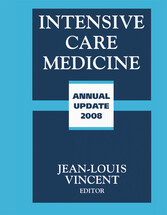Suchen und Finden
Table of Contents
5
List of Contributors
11
Common Abbreviations
27
I Genetic Factors
28
Are Pharmacogenetics and Pharmacogenomics Important for Critically III Patients?
29
Genetic Susceptibility in ALIIARDS: What have we Learned?
39
Racial Disparities in Infection and Sepsis: Does Biology Matter?
50
II Cardiac Issues
57
B- Type Natriuretic Peptide: An Emerging Biomarker in Pediatric Critical Care
58
=
61
@
70
The Consequences of Cardiac Autonomic Dysfunction in Multiple Organ Dysfunction Syndrome
80
Quantification of Improved Left Ventricular Performance during Cardiac Resynchronization Therapy
90
Diastolic Dysfunction and Cardiac Failure in the Intensive Care Unit
101
1\
108
V
108
V
108
Pharmacological Support of the Failing Right Ventricle
113
Perioperative Cardioprotection
126
III Cardiopulmonary Resuscitation
136
Improving the Quality of Cardiac Arrest Resuscitation Care
137
Pediatric Cardiopulmonary Arrest and Resuscitation
145
Early Cooling in Cardiac Arrest: What is the Evidence?
161
IV Emergencies
169
Management of Severe Accidental Hypothermia
170
1
173
1
173
1
173
1
173
1
173
7
173
Initial
183
Management of Skin Sloughing
183
Diseases: Toxic Epidermal Necrolysis and Stevens- Johnson Syndrome
183
V Poisonings
191
Extracorporeal Life- Support for Acute Drug- induced Cardiac Toxicity
200
Epidemiology of Acute Respiratory Failure and Mechanical Ventilation
212
VI Acute Respiratory Failure
211
Esophagectomy and Acute Lung Injury
222
Glucocorticoid Treatment in Acute Respiratory Distress Syndrome: Friend or Foe?
233
Regional Lung Function in Critically III Neonates: A New Perspective for Electrical Impedance Tomography
243
Extracorporeal Lung Assist for Acute Respiratory Distress Syndrome: Past, Present and Future
254
VII Ventilatory Support
262
Protective Mechanical Ventilation: Lessons Learned From Alveolar Mechanics
263
Hypercapnia: Permissive, Therapeutic, or Not at All?
287
The Cardiopulmonary Effects of Hypercapnia
300
High Frequency Oscillation for Acute Respiratory Failure in Adults
308
Airway Pressure Release Ventilation: Promises and Potentials for Concern
319
Postoperative Non- invasive Ventilation
328
VIII Tracheostomy
338
Choice of Tracheostomy Tube: Does One Size Fit All?
339
What's new in Percutaneous Dilational Tracheostomy?
347
IX Infections
357
Novel Therapies in the Prevention of Ventilator- associated Pneumonia
358
Management of Ventilator- associated Pneumonia
368
Flucytosine Combined with Amphotericin Bfor Fungal Infections: A Postmarketing Surveillance and Future Perspectives
380
X Cellular Mechanisms in Sepsis
388
Apoptosis in Critical Illness: A Primer for the Intensivist
389
Regulation of Mitochondrial Function by Hypoxia and Inflammation in Sepsis: A Putative Role for Hypoxia Inducible Factor
399
Gram- positive and Gram- negative Sepsis: Two Disease Entities?
409
XI Sepsis Therapies
425
The Cardiovascular Management of Sepsis
426
Terlipressin in Septic Shock: When and How Much?
436
Glutathione in Sepsis and Multiple Organ Failure Failure Failure
457
Selenocompounds and Selenium: A Biochemical Approach to Sepsis
467
XII Metabolic Alterations
483
The Role of Hypoxia and Inflammation in the Expression and Regulation of Proteins Regulating Iron Metabolism
484
Hyperammonemia in the Adult Critical Care Setting
492
Magnesium in the
502
Strict Glycemic Control: Not If and When, but Who and How?
513
Cortisol Metabolism in Inflammation and Sepsis
525
XIII Fluid Management
531
Assessment of Perioperative Fluid Balance
532
Fluid Resuscitation and Intra- abdominal Hypertension
545
XIV Acute Kidney Injury
558
Six Truths about Acute Kidney Injury that the Intensivist Should Be Aware Of
559
Role of Poly{ ADP- Ribose) Polymerase in Acute Kidney Injury
567
From Hemodynamics To Proteomics: Unraveling the Complexity of Acute Kidney Injury in Sepsis
576
XV Hemodynamic Assessment and Management
587
Towards Optimal Central Venous Catheter Tip Position
588
From Arterial Pressure to Cardiac Output
598
Hemodynamic Monitoring: Requirements of Less Invasive Intensive Care - Quality and Safety
609
Minimally Invasive Cardiac Output Monitoring: Toy Or Tool?
614
XV Hemodynamic Assessmentand Management
587
Bioreactance: A New Method for Non- invasive Cardiac Output Monitoring
626
Goal- directed Hemodynamic Therapy for Surgical Patients
638
XVI Tissue Oxygenation
645
Use of Mixed Venous Oxygen Saturation in ICU Patients
646
Early Optimization of Oxygen Delivery in High- risk Surgical Patients
659
The Influence of Packed Red Blood Cell Transfusion on Tissue Oxygenation
670
Recent Advancements in Microcirculatory Image Acquisition and Analysis
682
The Beneficial Effects of Increasing Blood Viscosity
696
XVII Anticoagulants in Organ Failure
706
Protein ( and Antithrombin Levels in Surgical and Septic Patients
707
Thrombophilia as a Risk Factor for Outcome in Sepsis
717
The Effects of Activated Protein ( on the Septic Endothelium
725
Improvement in Hemodynamics by Activated Protein ( in Septic Shock
734
XVIII Acute Bleeding
741
Gastrointestinal Hemorrhage on the Intensive Care Unit
742
Recombinant Activated Factor VII: The Delicate Balance between Efficacy and Safety
754
XIX Hepatic Disease
763
ICU Management of the Liver Transplant Patient
764
Liver Support with Fractionated Plasma Separation and Adsorption and Prometheus AE
778
Artificial Liver Support: Current Status
786
XX Neurological Crises
800
Multimodality Monitoring in Patients with Elevated Intracranial Pressure
811
Managing Critically III Patients with Status Epilepticus
822
XXI Analgesia and Sedation
837
Sedation with Inhaled Anesthetics in Intensive Care
838
Sedation or Analgo- sedation in the leu: A Multimodality Approach
849
XXII Outcomes
862
Time to Use Computerized Physician Order Entry in all ICUs?
863
Quality of Life in Locked- in Syndrome Survivors
879
Post- traumatic Stress Disorder in Intensive Care Unit Survivors
889
Alle Preise verstehen sich inklusive der gesetzlichen MwSt.








